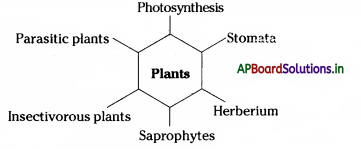Students can go through AP State Board 7th Class Science Notes Chapter 10 Nutrition in Plants to understand and remember the concept easily.
AP State Board Syllabus 7th Class Science Notes Chapter 10 Nutrition in Plants
→ The substances needed for the growth of a plant do not come from the soil only.
→ The green substance in the leaves is called chlorophyll.
→ Plants get water from the soil through their roots.
→ The main nutrients needed for plants are nitrogen, phosphorus, and potassium.
→ Cuscuta takes food from the plant on which it is climbing.
→ Saprophytes grow on -dead, decaying matter.
→ A few plants manufacture their own food but also obtain a part of their nutrition from insects.
→ Green parts of plants use carbon dioxide in the presence of sunlight (as well as other sources of light) along with water to make glucose, starch, and other food materials. This process of making food materials is called photosynthesis.
![]()
→ Plants that do not photosynthesize depend on other means of getting their nutrition.
→ Saprophytes live on decaying organic matter.
→ Insectivorous plants fulfill their nitrogen deficiency by trapping insects.
→ In symbiosis, organisms share their food and shelter.
→ Nutrition: Nourishing food, the study of food and its effects
→ Autotroph: Which prepare their own food materials
→ Chlorophyll: Green pigment of plants.
→ Photosynthesis: Synthesis of compounds with the aid of radiant energy
→ Stomata: A part of a leaf through which gases exchange takes place
→ Saprophyte: A plant that lives on dead organic matter.
→ Insectivorous: A plant that eats insects
→ Carnivorous: Animals that eat meat
→ SymbIosis: Close association of two species living together to their mutual benefit
→ Fungi: Mushroom or allied plant

→ Preservation of plant parts like leaves, flowers, or whole plants is a traditional designer art. If the plants are not available in a particular place then the plant physiologists collect those plants where they are available and make them in the preservative form. This is commonly known as an herbarium. They study those plants, and these preserved plants are also helpful for future studies.
There are colonies of algae and fungi living together in a symbiotic relationship! These colonies are known as Lichens. This relationship starts with the attack of the algal colony by a type of fungus. It is an example of balanced parasitism then. Later as algae survive, they are given protection from intense light and conditions of drying up due to the presence of fungus colony. The fungus gets food from its partner.
![]()
→ M.S Swaminathan:
Mom kombu Sambasivan Swam Nathan was born on 7th August 1925 at Kumbakonam in Tamilnadu. Swam Nathan is one of the responsible persons for the green revolution in India.
He introduced modern methods and techniques to raise agricultural production. He was the first agriculture scientist to win the Albert Einstein World Science Award in 1986.
At present, he is the Director of the MS. Swaminathan Research Foundation, Chennai.